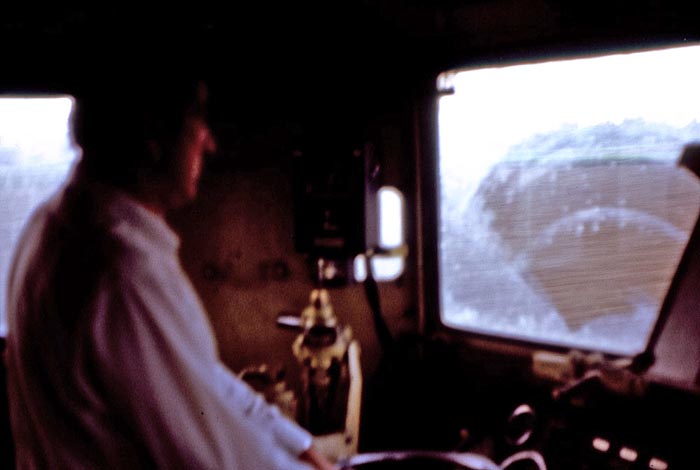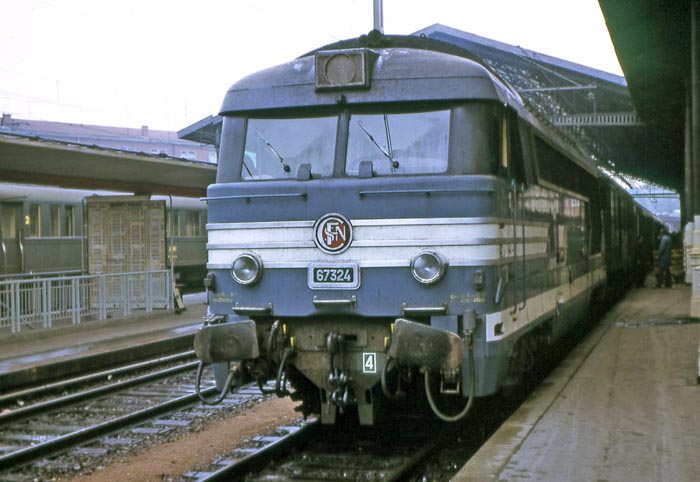My 1974 trip to the Soviet Union finished with a cab ride on the turbo train between Paris and Caen. This had me thinking about other "official" trips I have made in France.
On Monday 20 September 1971 I rode in the cab between Carcassonne and Toulouse
 A railcar and trailer at Carcassonne on a Quillan branch train
A railcar and trailer at Carcassonne on a Quillan branch train.
I travelled to Toulouse on train #5452 which left Carcassonne at 0913 and arrived at Toulouse precisely at 0958.
 The driver stood up for the entire journey
The driver stood up for the entire journey Passing through Castelnaudry at speed
Passing through Castelnaudry at speedThere is only one man on these locomotives. On this trip the driver was from Nimes and the locomotive was BB9237, 5570 hp. The acceleration is incredible. We were travelling at 140 km/hr (87.5 mph) within three minutes of the start. 140 km/hr is the maximum speed of these locomotives (or in fact 150 km/hr but the train vehicles are limited to 140 km/hr). The speed of 140 km/hr was adhered to regardless of the gradient for the whole way except for two speed restrictions. Speed was kept to 135-139 km/hr, tremendous skill on the part of the driver in knowing how his train reacts to gradients etc.
At Toulouse they are only allowed 8 minutes to change locomotives but this was possible with two coupeurs standing by. In fact the change over was completed so rapidly that I hardly had a chance to get off the locomotive.
 This diesel was quickly put on the train
This diesel was quickly put on the train
I came back to Carcassonne on train #4553 with locomotive BB9207 which, again, is 5570 hp. We had a late start due to a sticking brake on the leading fourgon and were delayed even further by the signals being out because of a cloudburst. The driver, this time from Toulouse, was a very cheery fellow but he was upset at the delays. We reached Carcassonne after a stop at Castelnaudry in the dark, nearly 45 minutes late. Still it did give me a very healthy respect for French locomotives and drivers.
In the dark on return at Carcassonne
1975
In 1975 I was a member of an industry delegation looking at French railway technology. There were several others from government and several Canadian railway men. The French were anxious to sell us TGV technology which they were in the process of implementing. There was only one day scheduled out of Paris - an afternoon visit by rail to Dijon and return.
After a morning meeting we were taken to the Gare du Nord and into the incredible restaurant Le Train Bleu.
The entrance to Le Train Bleu
There is a great view of one part of la Gare du Nord
The interior is stupendous - no wonder it is a listed location
In later years the restaurant had a cat. It was originally owned by a chef. The chef left but the cat decided to stay and it was put on the payroll as a rat catcher.
After an incredible lunch we were taken out to our train, Le Mistral which was one of the fastest at that time. Sitting in our first class accommodation we were asked if anyone wanted to ride on the engine. I immediately jumped up as did another government member, No railwaymen were interested.
The locomotive on Le Mistral. Both pantographs were raised to take account of the heavy current draw as we accelerated quickly out of the station.
In the cab I was introduced to the engineer and a traction inspector. The engineer was making calculations on the back of an envelope. I asked what he was doing. He told me
"There is a speed restriction just before we arrive at Dijon. I have calculated that this will cost me two minutes forty five seconds so I am working out where I can pick up that amount of time."
The inspector interjected. "He is not allowed to run over the maximum track speed and may not pick up more than three minutes on his schedule".
I had never seen this done before either in the UK or in Canada and I wondered whether they were trying to pull my leg.
However, we set out right on time and the driver was concentrating fiercely on his work. After about fifteen minutes he checked his watch against the schedule and announced
"I have picked up fifteen seconds so far."
The throttle is the circular wheel close to the driver. His schedule is in the middle right in front of him,
And so it went on. We gradually gained a few seconds on the schedule until he had accumulated two minutes and forty five seconds. We then came up to some track work and were diverted from one line to another. A few minutes later we ran into Dijon where the station clock moved on to the right time precisely as we came to a stop.
I was left with a high impression of the competence of French locomotive drivers.













Comments
Post a Comment